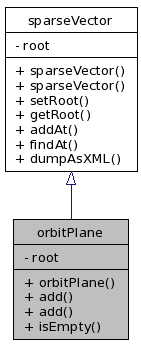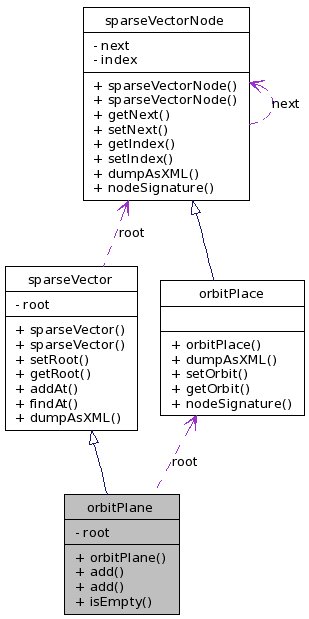
#include <orbit-plane.hpp>
Inheritance diagram for orbitPlane:


Definition at line 42 of file orbit-plane.hpp.
Public Member Functions | |
| orbitPlane () | |
| void | add (orbitPlace *op) |
| void | add (int ix, orbitPlace *op) |
| int | isEmpty (int ix) |
| orbitPlane::orbitPlane | ( | ) |
Generic constructor.
Definition at line 29 of file orbit-plane.cpp.
00029 : sparseVector() { 00030 root = new orbitPlace(); 00031 00032 }
| void orbitPlane::add | ( | int | ix, | |
| orbitPlace * | op | |||
| ) |
Place an object into the orbit plane at the spot specified by the passed parameters. See the caveat above. The orbitPlace object passed is updated with its orbit number.
| ix | integer value index to where the object should be placed. | |
| op | pointer to an orbitPlace object to be placed. |
Definition at line 39 of file orbit-plane.cpp.
References sparseVector::addAt().
00039 { 00040 this->addAt(ix,p); 00041 }
Here is the call graph for this function:

| void orbitPlane::add | ( | orbitPlace * | op | ) |
Add an item to the orbit plane using the parameter to determine at what orbit the object is to be placed. If an object already occupies that spot then the existing object is replaced by the new object.
| op | pointer to an orbitPlace object. |
Definition at line 34 of file orbit-plane.cpp.
References sparseVector::addAt(), and orbitPlace::getOrbit().
00034 { 00035 int ix = p->getOrbit(); 00036 this->addAt(ix,p); 00037 }
Here is the call graph for this function:

| int orbitPlane::isEmpty | ( | int | ix | ) |
Determine if a given orbit index is occupied or not.
| ix | integer index of the orbit we are interested in |
Definition at line 43 of file orbit-plane.cpp.
 1.4.7
1.4.7